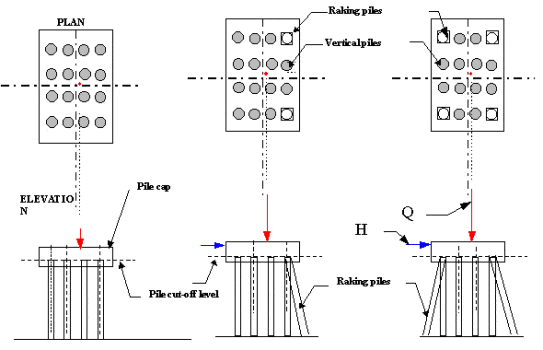Piles can be arranged in a number of ways so that they can support
load imposed on them. Vertical piles can be designed to carry vertical
loads as well as lateral loads. If required, vertical piles can be
combined with raking piles to support horizontal and vertical forces.
Often, if a pile group is subjected to vertical force, then the calculation of load distribution on single pile that is member of the group is assumed to be the total load divided by the number of piles in the group. However if a group of piles is subjected to lateral load or eccentric vertical load or combination of vertical and lateral load which can cause moment force on the group which should be taken into account during calculation of load distribution.
Piles arrangement
Normally, piles foundations consist of pile cap and a group of piles. The pile cap distributes the applied load to the individual piles which, in turn,. Transfer the load to the bearing ground. The individual piles are spaced and connected to the pile cap or tie beams and trimmed in order to connect the pile to the structure at cut-off level, and depending on the type of structure and eccentricity of the load, they can be arranged in different patterns. Figure bellow illustrates the three basic formations of pile groups.
Q = Vertically applied load
H = Horizontally applied load
Often, if a pile group is subjected to vertical force, then the calculation of load distribution on single pile that is member of the group is assumed to be the total load divided by the number of piles in the group. However if a group of piles is subjected to lateral load or eccentric vertical load or combination of vertical and lateral load which can cause moment force on the group which should be taken into account during calculation of load distribution.
Piles arrangement
Normally, piles foundations consist of pile cap and a group of piles. The pile cap distributes the applied load to the individual piles which, in turn,. Transfer the load to the bearing ground. The individual piles are spaced and connected to the pile cap or tie beams and trimmed in order to connect the pile to the structure at cut-off level, and depending on the type of structure and eccentricity of the load, they can be arranged in different patterns. Figure bellow illustrates the three basic formations of pile groups.
 |
| a) PILE GROUP CONSIST OF ONLY VERTICAL PILES | b) PILE GROUP CONSIST OF BOTH VERTICAL AND RAKING PILES | c) SYMMETRICALLY ARRANGED VERTICAL AND RAKING PILES |
H = Horizontally applied load
Figure: Basic formation of pile groups
No comments:
Post a Comment